Consuming Moldy Fermented Foods Is Unsafe
Jillian Epperly advocates that it is safe for consumers to eat moldy “fermented” salted cabbage which she refers to as "Jilly Juice." Jillian states that it’s safe for consumers to scrape off colorful mold and reuse some of the liquid for the next fermentation batch. I believe that it is dangerous for consumers to reuse liquid that has been contaminated with mold because it can lead to further contamination.
Jillian Epperly has even made a video where she demonstrates to consumers how she scrapes off mold from her own at home recipes.
Jillian has also supported the idea that people should reuse mason jars to use as fermentation vessels for her “Jilly Juice” recipe. I believe one of the major reasons why mold is commonly reported with the Jilly Juice recipe is because people are improperly fermenting food and using the wrong type of vessel. Using a fermentation crock with weights or using a proper airlock lid will help prevent the growth of air-born pathogens like mold. I personally believe it is imperative that consumers use the proper tools for at home fermentation. Especially when we consider the fact that the majority of consumers are unfamiliar with identifying toxic molds.
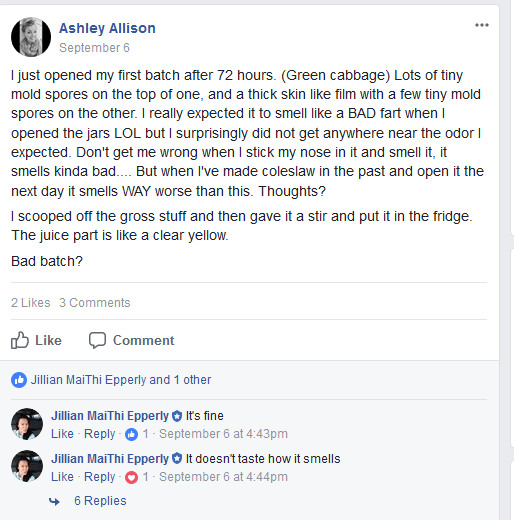
(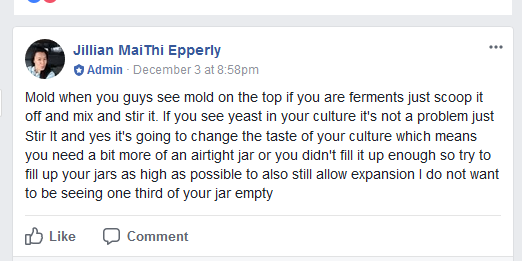 )
)
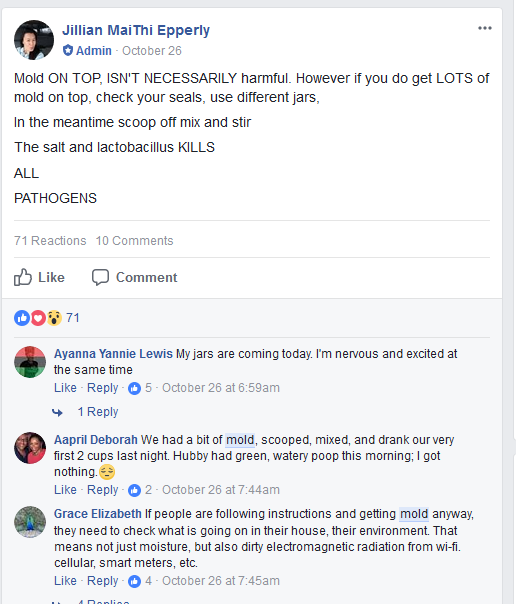
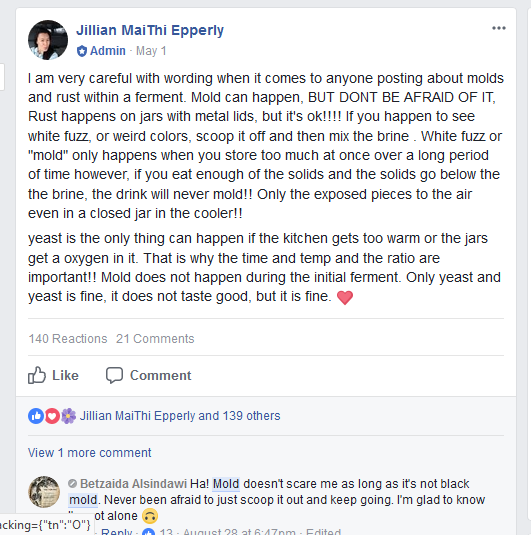
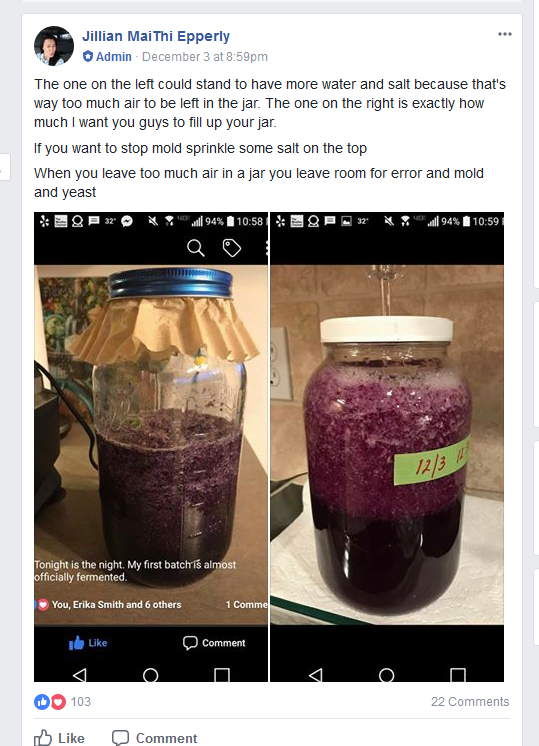
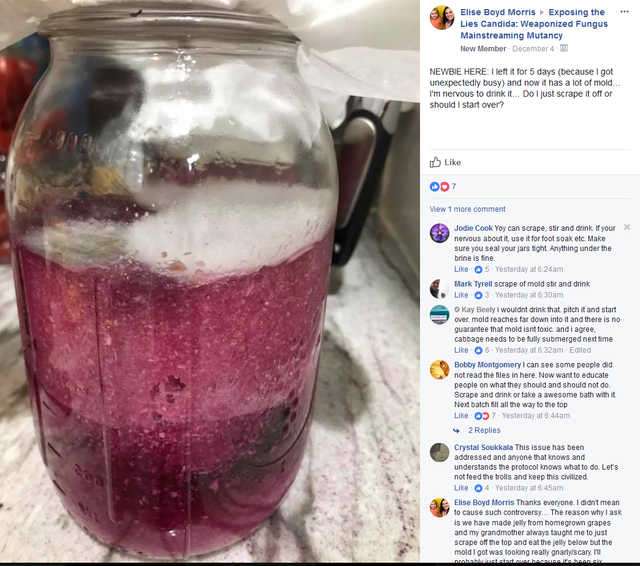
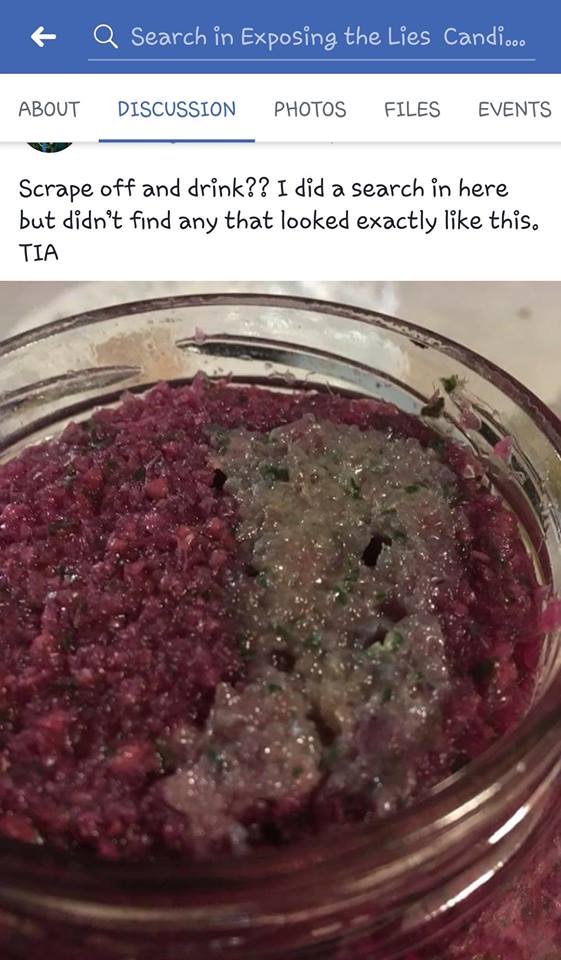
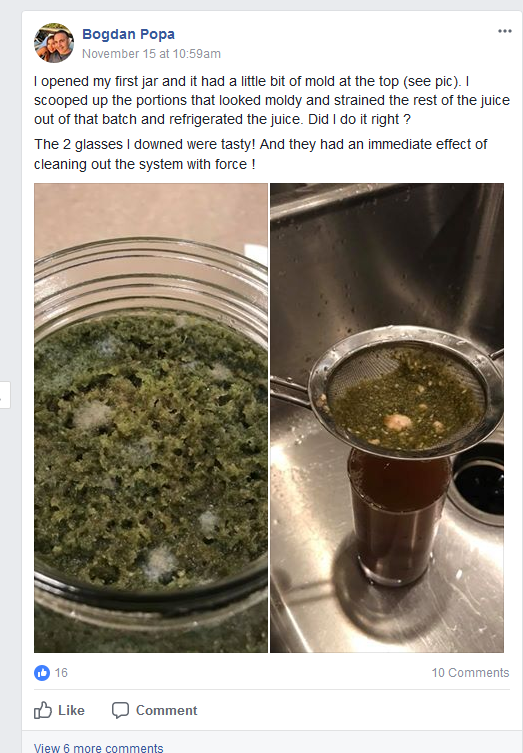
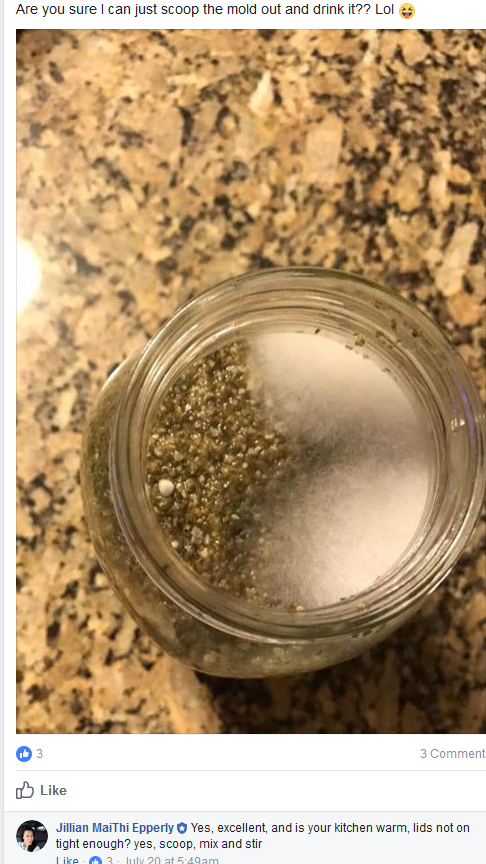
The discussion of mold in correlation with fermented foods is a very touchy and controversial topic. There is a strong debate between fermentation enthusiasts when it comes to dealing with the development of "kahm yeast" and "mold" which sometimes grows on fermented foods and beverages. The general consensus in the debate is that when kahm yeast develops, it's not dangerous to scrape the layer of kahm yeast off. Many people will scrape kahm yeast off and then allow the fermentation process to continue before consuming. The controversial contention happens when people begin to advocate that it’s "safe" to scrape layers of colorful mold off of fermented food and allow the culture to continue to ferment before consuming. There are plenty of online food bloggers that will argue that they have been scraping mold off their fermented foods for years and have never become ill. The FDA and other food regulatory agencies would firmly disagree with this practice.
One of the major reasons why the FDA requires "traditionally" fermented foods like saurkraut and kimchi to be pasteurized is to prevent the risk of harmful bacteria and mycotoxin growth. Commercial food businesses are required to adhere to strict production practices to ensure that food safety standards are met. Even though many argue that the process of pasteurization will kill off the probiotic cultures that are found in fermented foods, there is no denying the need for regulation and testing when it comes to large-scale food production.
For those that are interested in probiotic-rich foods, I understand and empathize with the internal conflict that mass food production and pasteurization presents. There are strong arguments that can be made regarding modern day food pasteurization. Ultimately, if you want probiotic fermented foods that are of the highest quality, you will have to learn how to properly ferment foods yourself. You will also have to educate yourself on how to deal with mold and yeast.
Mold does not simply impact the surface level of foods. It is important to understand that when mold develops on food it often has invisible “tentacles” that essentially grow and extend like roots. Merely removing the top layer of mold does not necessarily eradicate the contamination because the tentacles can expand deeply into the food item. It is also common to find bacteria within mold growth. Some bacteria can be very harmful to to humans. Certain types of mold can develop mycotoxins which can be detrimental to human health. The following article was published by the USDA and it discusses mold in correlation with foods.
https://www.fsis.usda.gov/…/a87cdc2c-6dd…/Molds_on_Food.pdf…
There are many side effects that can occur when a person eats tainted moldy food. Some of the symptoms can be mild while other symptoms are more severe.
Paul Stamets is a very well respected mycologist with over 40 years of fieldwork experience. He has authored several books about mushroom mycology. In 1995 Paul Stamets wrote an eloquent article discussing Kombucha, a popular fermented tea recipe. He discussed his personal concerns regarding kombucha and the potential for consumers to be unable to identify dangerous and harmful mold growths. Here is a quote from the article:
“I have seen several of my vessels spontaneously contaminate with molds. Of most concern are the species of Aspergillus I have found floating around with Kombucha. I fear that amateurs could think that by merely pulling out the Aspergillus colonies with a fork, that the culture would be de-contaminated, a dangerous, even deadly presupposition.
The water-soluble toxins of Aspergillus can be highly carcinogenic. Several species are known killers. Since the public can not be expected to distinguish a clean fermented culture from one which is not, I fear that the unreserved use of this tea will result, has resulted in illness, if not death. (See Newsweek, April 25th, 1995, pg. 6.)”
http://www.fungi.com/…/kombucha-my-adventures-with-the-blob…
On the opposition, one of the leading modern day fermentation authors, Sandor Kats, has a much more liberal and lenient approach when it comes to dealing with molds and yeast.Sandor Kats is the author of “The Art of Fermentation.” It is important to note that Sandor Kats consider himself an "Artist" of fermented foods. He is not considered an expert when it comes to molds, bacteria, and mycotoxins. Sandor Kats does a good job at attempting to educate people on the difference between kahm yeast and surface molds including the how/why these molds and yeast develop. He still often advocates the “scrape” method. Here is a quote from one of his articles:
“If the vegetables float to the top and remain exposed to air, they are likely to develop mold. Sometimes, especially in hot weather, your ferment may develop a film of white mold on its surface. This is very common and will not hurt you or the kraut. Scrape off the mold as best you can, don’t worry about particles that mix into the vegetables, and enjoy the delicious ferment beneath.”
https://www.wildfermentation.com/vegetable-fermentation-fu…/
There have been many studies done regarding bacteria and mycotoxins in correlation with fermented foods. While many of these studies have been conducted over-seas, it still presents a fair perspective on the reality that improperly fermented foods can have mycotoxins and other mold pathogens which have been proven to be harmful to human health.
https://www.ncbi.nlm.nih.gov/pmc/articles/PMC5705978/
http://cancerres.aacrjournals.org/content/28/11/2296
https://www.researchgate.net/…/288182136_Mycotoxins_Associa…
https://link.springer.com/article/10.1007/s12550-016-0257-7
I personally do not advocate that people "scrape" mold off of fermented foods. I advocate that people practice proper fermentation methods by using appropriate fermentation crocks and air-lock vessels, while maintaining a very high level of sanitation. It is also important that fermented foods be kept in a cool dark place. Unlike Jillian Epperly, I encourgae people to use heriloom seeded and organic produce when fermenting. I believe that GMO foods have a higher potential to have mycotoxins that can become harmful to our health when they are improperly fermented.
I have been a very strong advocate of the slow foods movement for many years. I enjoy preparing wholesome slow cooked meals that nourish my body. I also love fermented foods and drinks. I believe that saurkraut and kimchi represent some of the original "slow foods" that ancient civilizations had a deep understanding of. Before modern day pasteurization, ancient societies would often ferment their foods to ensure the longevity of the item. The book "Nutrition and Physical Degeneration" by Dr. Weston A. Price shows several examples of the benefits from traditional fermented foods in comparison to the modern "westernized" diet. It is very important to understand that as our modern society has advanced, we have not only expanded our capabilities and understandings of food production and preservation but we have also created new and unique problems that did not exist within ancient societies.
With the development and implementation of mass-produced GMO foods and the use of pesticides like glysophate, we have essentially changed the structure of the soil that food is grown in. Many people are unaware of the reality that soil is a living organism. Soil is comprised of many microbial structures. Our modern day, mass-scale agriculture practices have changed the microbial structure of soil and depleted the minerals and nutrients that were traditionally found in the soil. This creates an ideal environment for harmful virulent and disease-causing pathogens to grow in the soil and it also leads to the development of superbugs-all of these factors ultimately impacts the food that we eat.
https://articles.mercola.com/.../dr-don-huber-interview...
In my honest opinion, it is unfair to compare modern day food practices with ancient societies. We must accept that we are living in a genetically modified reality, the problems we face today are unlike the problems of the past. And while I am very passionate about these new age problems, I will save the topic for another article. The purpose of this article is to discuss how to deal with mold that develops in fermented foods.
Congratulations @healthwitch! You have received a personal award!
Click on the badge to view your Board of Honor.
Do not miss the last post from @steemitboard:
Congratulations @healthwitch! You received a personal award!
You can view your badges on your Steem Board and compare to others on the Steem Ranking
Do not miss the last post from @steemitboard:
Vote for @Steemitboard as a witness to get one more award and increased upvotes!